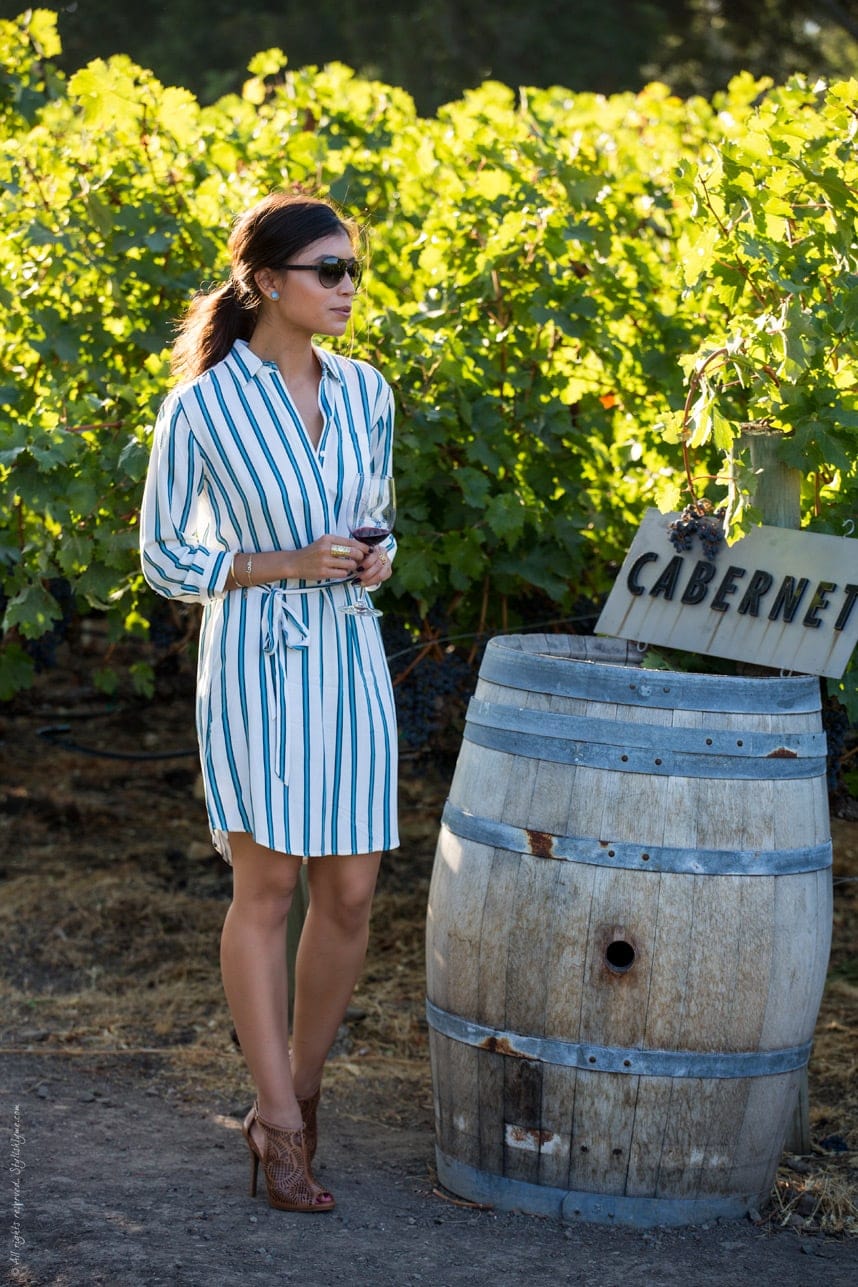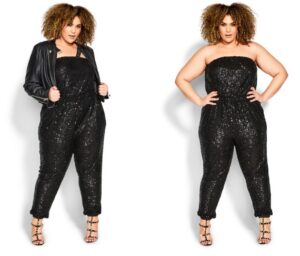To determine what to wear today, check the weather and dress appropriately for the temperature and conditions. The weather can change at a moment’s notice, so it’s vital to stay up-to-date with the latest forecasts to avoid being caught unaware.
The perfect attire is essential for any outdoor activity, be it work or leisure. Your body temperature must be regulated, and your clothes must protect you from the elements. An understanding of the weather forecast can guide your clothing choices and ensure that you are appropriately dressed for any event.
Additionally, dressing appropriately for the weather can help prevent illnesses caused by exposure, such as sunstroke, hypothermia, or dehydration. Let’s explore some pointers to assist you in selecting the right outfit for the climate, no matter where you are in the world.

Credit: stylishlyme.com
Understanding Weather-Dependent Fashion
Weather plays a significant role in determining what we should wear. It is essential to ensure that your outfit suits the temperature and precipitation for practical and aesthetic reasons. Here, we will delve into how different weather conditions affect fashion choices, and why it is vital to consider both temperature and precipitation when selecting an outfit.
How Different Weather Conditions Affect Fashion Choices
Weather conditions not only affect your mood but your fashion choices too. The following are a few examples:
- Hot weather: In hot weather, it’s a good idea to wear light and airy clothes. Cotton, linen or rayon are perfect for beating the heat.
- Cold weather: Layering is the key to stay warm in chilly temperatures. Sweaters, jackets and sturdy boots help maintain body heat.
- Rainy weather: Invest in a waterproof jacket or trench coat and choose water-resistant footwear. Ditch the heels and opt for ankle boots.
Consider Both Temperature And Precipitation When Selecting An Outfit
Both temperature and precipitation should be considered when selecting an outfit for the day. Why?
- Temperature affects the texture of your clothes. Silk or satin are not ideal for chilly weather, while cotton or wool sweaters are perfect for keeping warm.
- Precipitation affects the material of your clothes. Light-coloured fabrics and suede should be avoided on rainy days. Instead, choose waterproof materials, which help keep you dry.
Examples Of Weather-Dependent Fashion Choices
Different weather conditions call for different fashion choices. Here are a few examples:
- Hot weather: Light and airy clothes such as sundresses, shorts or linen shirts are perfect for hot summer days.
- Cold weather: Winter coats, wool socks and gloves are ideal for when the temperature drops.
- Rainy weather: A trench coat, rain boots and an umbrella are great options for when it’s wet outside.
Remember, your outfit should not only be weather-dependent, but also make you feel comfortable and confident throughout the day.
Summer Fashion
Summer is here and it’s time to bring out those breezy outfits. The key to summer fashion is comfort, while still maintaining an elegant look. Here are a few tips to help you dress stylishly when it’s hot outside.
Discuss Fashion Choices Appropriate For Hot Weather
When the sun is blazing, it is important to choose outfits that are light and airy. Here are some fashion choices that are perfect for hot and humid climates:
- Loose tops or dresses: Opt for flowing and breathable fabrics that don’t stick to the skin. This will allow air to circulate, keeping your body cool and comfortable.
- Shorts: From denim shorts to linen shorts, they are great for when the temperature rises. They are practical and stylish, making them an ideal summer outfit choice.
- Sunglasses: Not only do sunglasses complete your outfit, but they also protect your eyes from harmful uv rays.
- Comfortable footwear: Sandals, flip flops and sneakers are perfect for summer weather. Avoid boots or closed shoes as they can make your feet feel hot and sweaty.
Provide Tips For Staying Cool While Maintaining A Stylish Look
It’s important to stay cool in hot weather. Here are some tips to help you keep cool while still looking chic:
- Wear light-colored clothing: Dark colors absorb more heat, so it’s best to opt for light-colored fabrics such as white, pastels or floral prints.
- Choose breathable fabrics: Avoid fabrics like polyester and opt for cotton, linen, or rayon instead. These fabrics are breathable and will allow air to circulate, keeping you cool.
- Accessorize with hats: A fashionable hat will keep the sun off your face, keeping you cool and stylish at the same time.
- Keep yourself hydrated: Drink plenty of water to keep yourself hydrated. You can also carry a small hand-held fan to keep you feeling fresh.
Discuss Appropriate Fabrics And Colors For Summer Fashion
Choosing the right fabric and colors for summer is crucial for comfort and style.
- Fabrics: Opt for fabrics that are breathable and lightweight. Cotton and linen are perfect choices that keep you cool and stylish in hot weather.
- Colors: Summer is the perfect time to play with colors. Choose pastel colors and light hues like baby blue, pink, yellow and white. Dark colors like black and navy will make you feel hotter, so it’s best to leave them for the colder months.
Dressing stylishly in summer is about choosing the right fabrics, colors and accessories that not only look good but also keep you comfortable. With these tips, you can stay cool and breezy even when the temperature is soaring.
Winter Fashion
Winter is the season when layering up becomes a necessity, but that does not mean you have to compromise on style. With the right fashion choices, you can stay both warm and fashionable. In this section, we will discuss the various aspects of winter fashion, from fabric to color choices.
Discuss Fashion Choices Appropriate For Cold Weather
When it comes to winter fashion, the first thing that comes to mind is layering. Layering not only keeps you warm but also creates a stylish look. Here are some appropriate fashion choices for cold weather:
- Coats: Wool coats, trench coats, and parkas are perfect for winter. They provide warmth and are stylish as well.
- Sweaters: Sweaters are a must-have for winter fashion. You can never go wrong with a classic cable-knit sweater or a cozy turtleneck.
- Boots: Boots are a practical and fashionable choice for winter. From ankle boots to knee-high boots, they come in various styles that can elevate any outfit.
Provide Tips For Staying Warm While Maintaining A Stylish Look
Nobody wants to sacrifice fashion for warmth during winter. Here are some tips to stay warm while still looking stylish:
- Layering: Layering is your best friend during winter. Layering can also include accessorizing with hats, scarves, and gloves.
- Invest in quality outerwear: Investing in good-quality outerwear can last you years and will always be in style.
- Opt for thicker fabrics and chunky knits: Fabrics like wool, cashmere, and fleece are perfect for winter. Chunky knits and tweeds also provide warmth and texture to any outfit.
Discuss Appropriate Fabrics And Colors For Winter Fashion
Choosing the right fabrics and colors for winter fashion is crucial. Here are some appropriate fabrics and colors that are perfect for winter:
- Fabrics: Wool, cashmere, fleece, and shearling are all appropriate for winter fashion. They provide warmth while still being stylish.
- Colors: Winter colors such as black, navy, grey, and burgundy are always in style. You can also incorporate brighter colors like red or emerald green for a pop of color in your outfit.
You don’t have to compromise style for warmth during winter. By layering, investing in quality outerwear, and choosing the right fabrics and colors, you can stay both warm and fashionable.
Transitional Seasons (Spring And Fall) Fashion
Discuss The Challenges Of Dressing For Transitional Seasons:
Dressing for transitional seasons, like spring and fall, poses a significant challenge because the weather can be unpredictable. One moment, it may be warm and sunny, while the next it becomes chilly and windy. As such, it can be challenging to decide what outfit to wear that can transition well between different temperature ranges.
If you want to avoid carrying around unnecessary layers throughout the day, you need to select outfits that can adapt to changing weather conditions.
Provide Tips For Choosing Outfits That Can Adapt To Changing Weather Conditions:
Choosing outfits that adapt well to changing weather conditions is critical in transitional seasons fashion. To achieve this, consider the following tips:
- Choose lightweight and breathable fabrics that can keep you cool during warm days, such as cotton, linen, and rayon.
- Invest in versatile pieces that can be layered up or down depending on the weather, such as cardigans, blazers, and scarves.
- Opt for pieces with adjustable lengths, such as sleeves, pants, or skirts, since they can easily adapt to different weather conditions. For example, consider wearing a long skirt or maxi-dress that you can wear with a cardigan or a denim jacket when it gets chilly.
- Pick outfits that can easily be dressed up or down, so you can switch from day to night attire without changing into a completely different outfit.
Discuss Appropriate Fabrics And Colors For Transitional Seasons Fashion:
Selecting appropriate fabrics and colors for transitional seasons fashion is vital to get the most out of your outfit. Here are some tips to guide you in your selection:
- Choose fabrics that can be layered on top of each other, such as cotton, denim, and leather. Denim jackets, coats, and leather jackets are perfect for layering in transitional seasons.
- Opt for colors that can easily transition well between seasons, such as neutral or earthy tones. Shades of beige, brown, green, and navy blue work well in transitional seasons fashion and can be paired with many outfits.
- You can also consider printed or patterned outfits, like floral or stripe prints, which can be paired with solid jackets or cardigans. These can add a pop of color to your outfit and still be versatile enough to transition between different weather conditions.
Dressing for transitional seasons can be challenging, but with the right tips and tricks, you can create outfits that easily adapt to different weather conditions. By choosing versatile pieces, breathable fabrics, and appropriate colors, you can create a wardrobe that transitions seamlessly throughout the spring and fall seasons.
Accessories
Discuss The Importance Of Weather-Appropriate Accessories
Accessories are a crucial aspect of any outfit, particularly when it comes to dressing for weather-dependent fashion choices. Choosing weather-appropriate accessories can help you stay comfortable and stylish while also protecting you from harsh weather conditions.
Some key points to consider when it comes to weather-appropriate accessories are:
- Different accessories suit different weather conditions. For example, a scarf and gloves might be ideal for chilly winter weather, but they might not be necessary in milder autumn temperatures.
- Accessories can add an extra element of style to your outfit while also serving a practical function. A raincoat or umbrella might be essential for staying dry on a rainy day, but they can also be a trendy fashion statement.
- Investing in weather-appropriate accessories can save you money in the long run. For example, a good pair of boots can last you several winters, rather than needing to buy cheap, poorly-made footwear every year.
Provide Examples Of Accessories That Can Complement Weather-Dependent Fashion Choices
Choosing the right accessories for different types of weather can help you stay comfortable and fashionable. Here are some examples of weather-appropriate accessories to consider:
- Cold weather: Scarves, gloves, hats, earmuffs, thick socks, boots, jackets, and puffer coats are all great options for staying warm while looking stylish.
- Hot weather: Sunglasses, hats, lightweight and breathable clothing, sandals, and sunscreen are all essential accessories for staying cool in the heat.
- Rainy weather: Raincoats, umbrellas, rain boots, and waterproof bags can help you stay dry while also adding a pop of color or style to your outfit.
- Windy weather: Scarves, hats, and jackets can protect you from the wind and add an extra layer of warmth.
Highlight The Role Of Accessories In Completing An Outfit
Accessories play a crucial role in completing an outfit and adding an extra element of style to your look. They can help you express your personality and style while also serving a practical purpose, such as keeping you warm or protecting you from the sun.
Here are some key points to consider when it comes to the role of accessories in completing an outfit:
- Accessories can add a pop of color, texture, or pattern to an outfit, drawing attention and enhancing your personal style.
- They can be used to complement or balance out other elements of an outfit, such as adding a bold accessory to an otherwise simple outfit, or toning down a bold outfit with more subtle accessories.
- Accessories can also be used to transition an outfit from day to night, such as swapping out a daytime bag for a clutch or statement earrings.
- Choosing the right accessories can make you feel more confident and put-together, adding an extra boost to your overall look.
Frequently Asked Questions Of What To Wear Today Weather
What Should I Wear On A Sunny Day?
On a sunny day, you should wear light-colored and lightweight clothes made of cotton or linen fabrics. It is best to wear a wide-brimmed hat and sunglasses for sun protection.
What Clothes Are Best For A Rainy Day?
For a rainy day, you should wear clothes made of water-resistant fabrics like polyester or nylon. Trench coats, raincoats, and waterproof boots are the best options to stay dry.
What Accessories Should I Wear On A Windy Day?
On a windy day, it is best to wear accessories like a scarf, a hat, and gloves to keep yourself warm and protected from the blowing wind. Avoid wearing loose clothing that can be easily blown away by the wind.
What To Wear For A Hot And Humid Day?
On a hot and humid day, wear loose and lightweight clothing made of breathable fabrics such as cotton or linen. Avoid wearing polyester or silk as they do not absorb sweat and may lead to discomfort.
What Kind Of Shoes Should I Wear On A Snowy Day?
Wear shoes that are water-resistant, slip-resistant, and have good traction. Boots made of leather or waterproof material with a fleece or synthetic lining are the best option to keep your feet warm and dry on a snowy day.
Conclusion
Now that you know what to wear in different kinds of weather, you won’t have to worry about feeling uncomfortable or out of place. It’s important to keep in mind the basics such as layering, choosing breathable fabrics, and checking the forecast before heading out.
Don’t be afraid to add your personal touch to your outfits and experiment with different styles. Remember, what you wear can affect your mood and confidence, so choose something that makes you feel good. Investing in versatile pieces can also save you time and money in the long run.
By following these tips, you can create a stylish and comfortable wardrobe that you can rely on no matter the weather.





